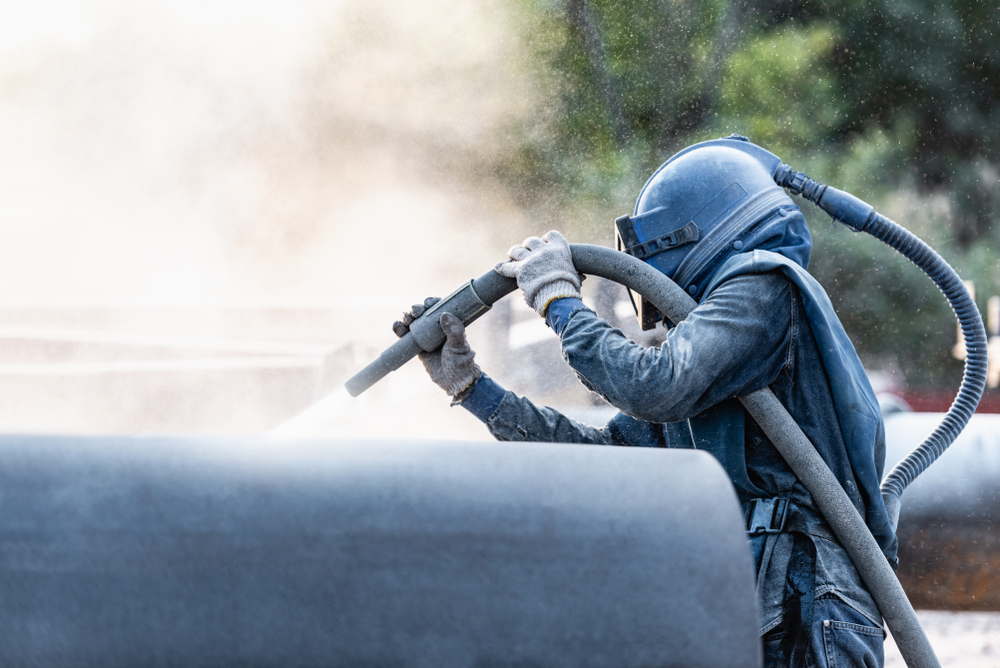For laser cleaning we are using a laser beam with a power of 1000W and more to remove surface contamination. This may not seem very much, but this power is concentrated on a very small surface, creating a very high energy density.
This way the fine point of light can generate a very strong heating on the material it is shining on in a very short amount of time. Specifically this means you only need a fraction of a second to bring metal to it’s melting point or even to it’s evaporation point. This also the way laser cutters work: the evaporate the beamed on material so they can cut a couple of centimeters of steel as if it were butter.

Sandblasting is a very widespread technique for the cleaning of contaminated layers. Grains of sand (or now more often other grains) are shot at high speed against the contaminated layer because of the use of the compressed air. An abrasive process takes place due to the high speed and the rough form of the grains. In other words: the pollution wears away or crumbles. Sandblasting is a cleaning technique that can be used for the cleaning of facades, ships and industrial parts. It removes rust, but not only that, also coatings, old paint layers and other forms of pollution. Sandblasting isn’t the best option for very thin layers because the grains also wear off the underlying layers, what most people obviously do not want. There also needs to be an enclosed area and a special suit to protect the environment and the operator, because the grains, together with the pollution that came off, fly around at high speed. A lot of the times, loose grains stay on the treated area, which requires manual cleaning after the process is done. There are also sandblasting machines in which the workpiece is placed and where automatic cleaning then takes place.
Dry ice blasting is very similar to sandblasting. But unlike sandblasting, no grains are left behind after the process is done. The grains immediately evaporate after the impact on the surface that is being cleaned because the grains are made of dry ice, which is actually frozen CO2. The pollution that came off, flies around in the area here too, which makes shielding necessary. Dry ice blasting is less often used for large surfaces, like ships and facades, but is frequently used for the cleaning of machine parts, old-timers and molds. Just like with sandblasting, the workpiece also wears away because of the dry ice particles, so when cleaning multiple times, wear will occur on the parts that need to be cleaned.
Pyrolysis is an interesting technique for the cleaning of large quantities of parts or for hard to reach places like corners and edges. With this technique, the workpiece is placed in a pyrolysis oven and heated to a high temperature. The pollution, often carbon-based, evaporates, leaving the workpiece untouched. After ten or more hours in the oven, the pieces are clean. When using pyrolysis, you should always pay attention to thermal deformation of the pieces and to the change of the surface properties of the underlying layer. This technique can only be used when you are able to disassemble the workpiece to fit the parts into the oven. This is why pyrolysis isn’t suitable for large or solid surfaces. One of the typical applications is the cleaning of industrial baking trays, which are not so big, are used in large quantities and are frequently contaminated with organic components that are easy to evaporate. Sometimes, pyrolysis gets combined with a light form of sandblasting, which we call fluidized bed cleaning.
With chemical cleaning, the pieces that need to cleaned are put into a bath with a chemical solution. These baths are usually at a high temperature to speed up the chemical reaction with the pollution. After several hours or days in the bath, all the pollution is gone and the pieces are clean again. Just like with pyrolysis, the workpieces need to be disassembled and taken to the cleaning company to do the cleaning there. Companies usually don’t have their own chemical cleaning because this requires specific permissions because of the environmental legislation. The aspect of the environment is now more and more seen as a disadvantage of chemical cleaning, together with the total turnaround time of a full cleaning. Not every material is suitable for this type of cleaning because of possible reactions with the chemical baths. A specific application of chemical cleaning is the cleaning of pipes, which are hard to clean with other methods. There is a chemical liquid that is being pumped through the pipes to remove the pollution.
This technique is well known to the public. In the industry, much higher pressures and temperatures are used. Water pressures of more than 1000 bar aren’t exceptional here and are able to remove very stubborn pollution. Despite the use of a seemingly harmless liquid like water, there is still a risk of permanent wear or damage to the surface. High pressure water is even used to cut steel and this can be an unwanted side effect when cleaning with this technique. Because of all the high pressures, safety is very important and shielding is absolutely necessary. The pollution that comes off and water mist spread very far into the environment, which is something we do not want. High-pressure cleaning is very suitable for large surfaces and is financially interesting because the cleaning product, water, is very cheap.

Interested in laser cleaning? Experience a free demo at our demo center to see all the advantages of laser cleaning for yourself.